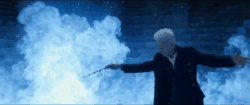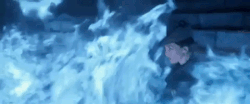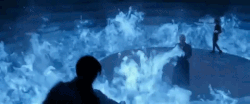What Was the Blue Fire in Crimes of Grindelwald
watch 01:54
Obi-Wan Finale - The Loop
Protego Diabolica was the incantation of a powerful dark charm[2] that allowed the user to create a protective ring of black fire around them that completely incinerated enemies of the caster who came into contact with it while leaving their allies unharmed.[1] [3] It was similar to Fiendfyre, but was a different spell.[2]
History

Grindelwald controlling the fire to separate his enemies from his allies
In 1927, Gellert Grindelwald cast this spell in the Lestrange Mausoleum to test the loyalty of his followers and kill a number of his enemies, most of whom were Aurors trying to arrest him. Because they were loyal, Vinda Rosier, Queenie Goldstein, Abernathy, and Credence Barebone all passed through the fire into the circle. Krall, who considered turning against Grindelwald, failed to enter. Several victims who never attempted to cross either escaped the ring or fell to its wrath.[1]
During the 1990–1991 school year, Professor Albus Dumbledore came to conclude that Jacob's life-threatening burns that he was being treated for at St Mungo's was Protego Diabolica, and informed Jacob's sibling about it. Jacob's sibling then told Healer Miriam Strout about this at St Mungo's, and she went to adjust Jacob's treatments accordingly, telling them that their brother would be healed soon, and that she was surprised he had survived such a spell, assuming Jacob must have used the Shield Charm at the right time. Strout's treatments managed to save Jacob's life, and a recovering Jacob told their sibling from his hospital bed that he had indeed found Dai Ryusaki's Dark Scroll in a cave in Japan, and that Protego Diabolica sprung a trap around it when he tried to reach it.[2]
Casting and effects

As a true follower, Vinda safely crossing the circle of flames
When cast, Protego Diabolica created a protective ring of black fire around the caster. It was possible to walk through the flames unharmed, as demonstrated by Vinda Rosier, Credence Barebone, Queenie Goldstein and Abernathy amongst others, only if they were loyal to the caster and meant them no harm. Krall, who expressed doubts about Grindelwald's goals and methods earlier and thus showed an insufficient amount of loyalty towards Grindelwald, was burnt to ash within a few moments of entering the fire.[1]

Krall dying in the flames
Grindelwald was also seen controlling the spell as an offensive weapon by causing tendrils of black fire to extend from the ring and burn his enemies, mainly Aurors. The tendrils could be deflected or blocked, temporarily, with the Shield Charm.[1] [2]
Grindelwald was able to unleash the ring of fire in an attempt to destroy Paris. The fire soon manifested as what appeared to be a fiery, winged demon or dragon within it as it spread and burnt everything in sight, similar to the effects of Fiendfyre. It was so powerful that it required the combined usage of the General Counter-Spell by Newt and Theseus Scamander, Tina Goldstein, Yusuf Kama and also Nicolas Flamel to properly contain and extinguish the dark fire before it destroyed the whole city of Paris.
Burns inflicted by this spell could not be treated by Burn-Healing Paste.[2]
Etymology
- The incantation comes from Latin "protego", "I protect", and "diabolica", a declension of "diabolicus", meaning "diabolic, relating to the Devil".
- It is unclear if the translation is meant to suggest "protection from the devil" or "the devil protects". As the spell is used to divide friend from foe, one can assume that the former translation is accurate, as Grindelwald was dividing himself from those whom he considered "the enemy" (also a euphemism for Satan). However, given Grindelwald's real intentions and his habit of using irony and misleading phrases (such as the phrase "The Greater Good" when he is, in fact, inflicting suffering rather than good), it could very well be the latter.
Behind the scenes
- In Fantastic Beasts: The Crimes of Grindelwald - The Original Screenplay, the spell creates a "circle of black fire", whereas in the film the flames are bright blue. This is most likely due to the other tones of the scene being too dark for black fire to properly be seen. Therefore, a blue fire might have been used instead to show contrast to these dark tones.
- The spell's trait of rapidly spreading and growing in size and being able to create bestial entities out of its flames is remarkably similar to Fiendfyre, suggesting the spells are related. Additionally, the spell shares similarities to Bluebell Flames, which can seemingly be made to only damage certain targets and objects, as well as the caster being able to direct its movement to an extent. Also, it is similar to the black and purple flames that Severus Snape added to the protections for the Philosopher's Stone. The flames of Protego Diabolica and the black and purple flames have specific ways of being crossed unharmed, and not following the specific way will have negative effects to the victim.
- Due to this spell's extremely dangerous, lethal and powerful nature and similarity to Fiendfyre, it is most likely a curse, although this spell has yet to be officially labelled as one.
Appearances
- Fantastic Beasts: The Crimes of Grindelwald - The Original Screenplay (First appearance)
- Fantastic Beasts: The Crimes of Grindelwald
- A Spellbinding Guide to the Films (Harry Potter and Fantastic Beasts)
- Harry Potter: Hogwarts Mystery (Mentioned only)
- Harry Potter: Magic Awakened
Notes and references
- ↑ 1.0 1.1 1.2 1.3 1.4 1.5 1.6 1.7 Fantastic Beasts: The Crimes of Grindelwald - The Original Screenplay, Scene 114
- ↑ 2.0 2.1 2.2 2.3 2.4 2.5 Harry Potter: Hogwarts Mystery, Year 7, Chapter 23 (The Legend Of Dai Ryusaki And The Dark Scroll)
- ↑ Fantastic Beasts: The Crimes of Grindelwald - Fantastic Beasts: A Cinematic Yearbook
Source: https://harrypotter.fandom.com/wiki/Protego_Diabolica
0 Response to "What Was the Blue Fire in Crimes of Grindelwald"
Post a Comment